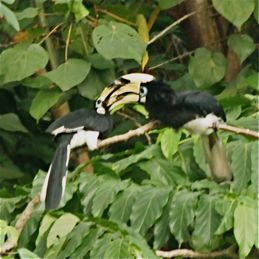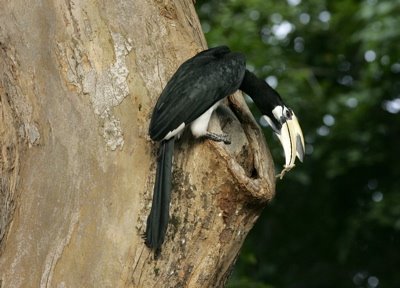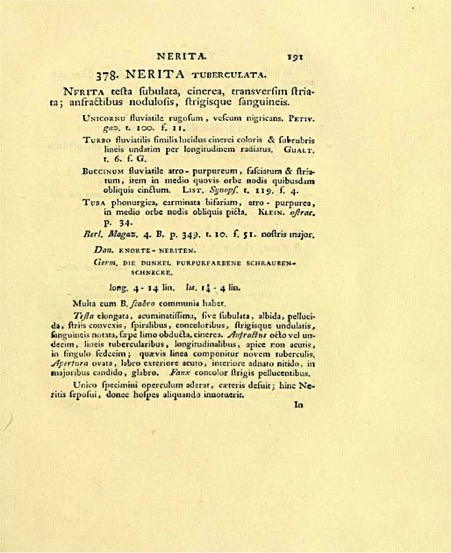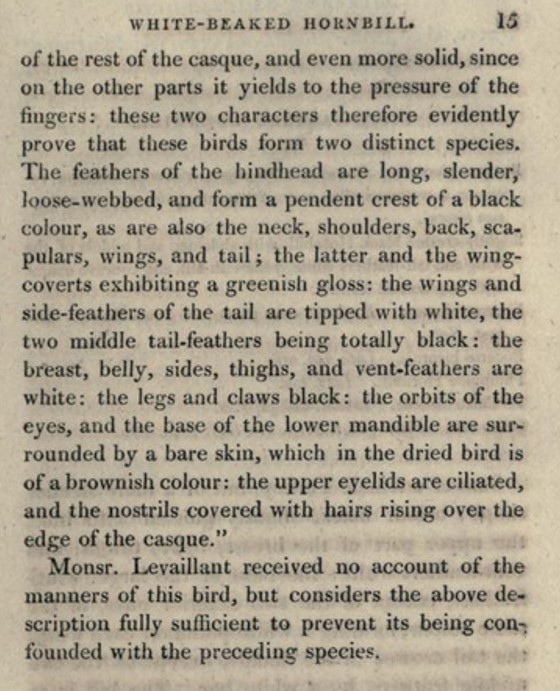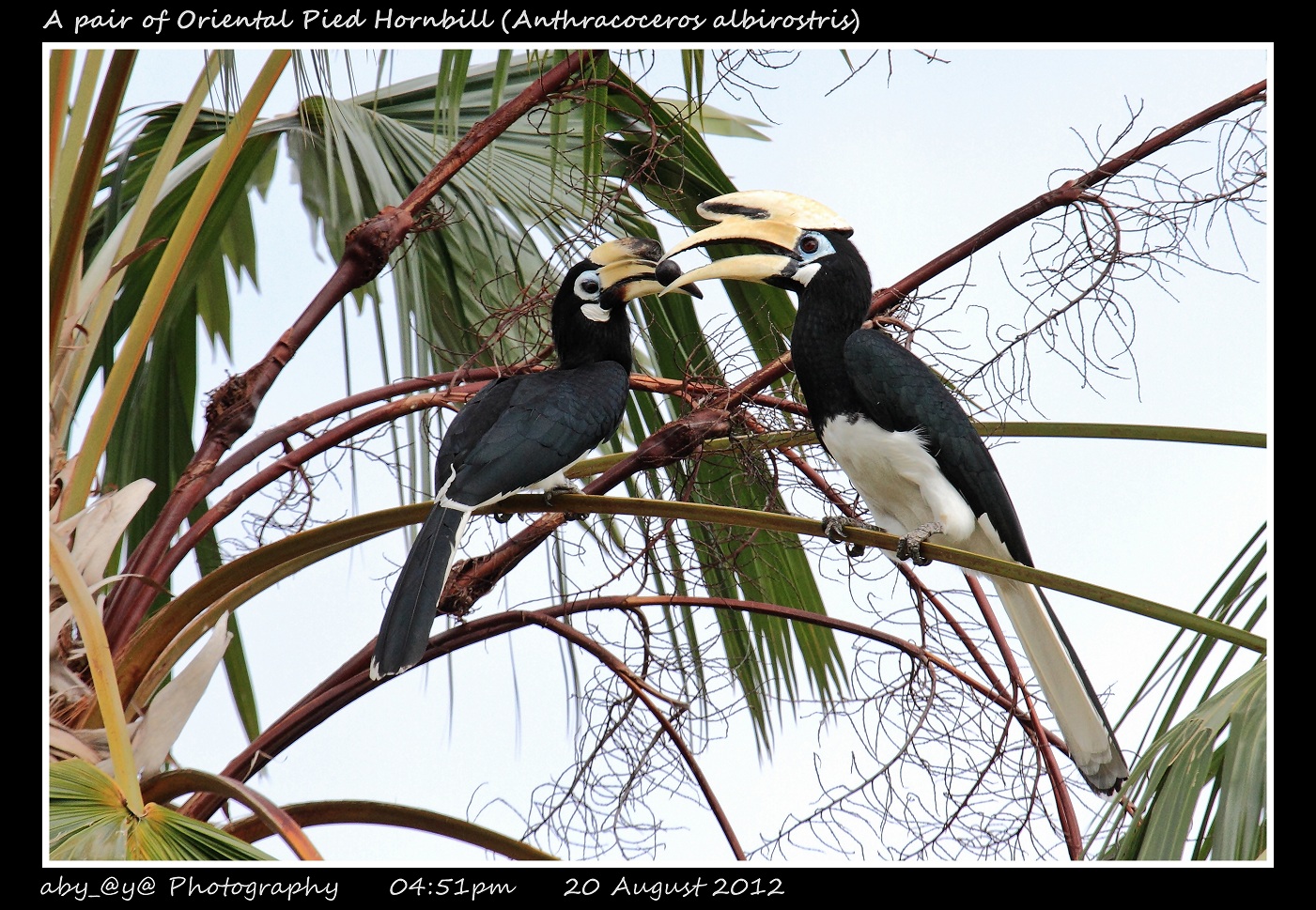 |
| Photo by: zhongying koay www.flickr.com |
Table of Contents
DESCRIPTION
I. JUVENILE
 |
| An Oriental pied hornbill hatchling. Photo from http://wrscomsg.wordpress.com |
 |
| Bill of oriental pied hornbill chick showing developing casque. Photo by: Howard Banwell (Banwell & Lim, 2009) |
II.ADULTS
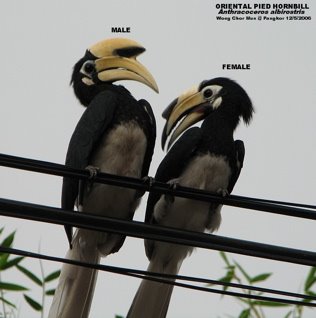 |
| Photo by: Susan Wong http://besgroup.blogspot.sg |
 |
| Male Oriental pied hornbill. Photo by: Jeff Lim (Banwell & Lim, 2009) |
Colour: Basically a black-and-white bird: mostly black with a white belly and thighs, and white accents around the eye, on the wing tips and tail.Trademark: Large, long bill. Adults have a casque (a knob on top of the bill) which is yellow-white. The male has a larger casque with few black marks, while the female has a smaller casque with more black marks.Size: This species is the smallest among Asian hornbills, with males measuring from tip of bill to tip of tail 55-60cm and females being slightly smaller. The wing length ranges from 23-36cm, the bill up to 19cm in males and up to 16cm in females.
DIAGNOSIS
There are currently five recognised species under the genus Anthracoceros.
A. albirostris was long considered to be conspecific with A. coronatus and the two species have been confused several times since their first discovery in the 1800s, leading to synonymy of common and scientific names. A. albirostris is smaller than A. coronatus, has less black on casque and pale blue (instead of pink-tinged) throat skin.
| Species |
Picture |
Distribution |
Habitat |
Brief description |
Global conservation status |
||||
| Anthracoceros coronatus (Malabar pied hornbill) |
|
Restricted to central and southern India, and Sri Lanka |
Evergreen forest, tall deciduous forest, also more open patches of forest and plantations. Sometimes seen at fruiting trees well outside forest. Confined to land under 300m. |
|
Near threatened |
||||
| Anthracoceros albirostris (Oriental pied hornbill) |
|
A widespread resident in northern South Asia, southern China, Indochina and western Indonesia |
Open habitat such as forest edge, clearings and secondary forest. Occurs up to 700m. |
* Black and white plumage with white patch under the eye, white lower belly, thighs, and undertail coverts, white tips to flight feathers and white outer tail feathers
|
Least concern |
||||
| Anthracoceros malayanus (Black hornbill) |
|
Confined to the Sundaic lowlands of peninsular Thailand, Sabah, Sarawak and Peninsular Malaysia, Kalimantan and Sumatra, Indonesia and Brunei |
Lowland primary evergreen forest. Usually below 200m. |
Male* Black plumage
Female
|
Near threatened |
||||
| Anthracoceros marchei (Palawan hornbill) |
|
Endemic to Palawan and its satellite islands in Philippines |
Forests, mangrove swamps, cultivated land, bushland, secondary growth and mountain forest. Occurs up to 900m. |
|
Vulnerable |
||||
| Anthracoceros montani (Sulu hornbill) |
|
Endemic to three islands in the Sulu archipelago in southern Philippines. |
Evergreen forest in lowlands and highlands. |
|
Critically endangered |
BIOLOGY
I. FEEDING HABITS
The Oriental pied hornbills are omnivorous. Food is usually brought by the male and consist of fruits, insects like beetles and crickets, spiders, lizards and even newly hatched bird chicks (Banwell & Lim, 2009). These are generally what hornbills eat, as well as what they feed their chicks (Collar, 2001). By volume, fruits predominated, with figs from the bodhi tree (Ficus religiosa) constituting a significant quantity (Banwell & Lim, 2009).
|
|
II. REPRODUCTION
Mating begins with courtship feeding, as the male offers the female a fruit or an animal prey. Courtship may also include interlocking of bills. The male will then entice the female to enter an appropriate cavity in an old tree with food. If successful, they will proceed to seal off the entrance with a plaster of mud and fibres. This is done by the male gathering and delivering earth to the female, which seals herself inside the cavity. A narrow slit is left open so that he can feed her and the chicks. This remarkable behaviour is believed to deter large predators. After a period of about 3 months when the chicks are about to fledge, the female will break open the seal and emerge.Breeding season: During the dry season, from February to May (Poonswad et al., 1987). On average, the number of nestlings that fledge per season is low, with only 1.5 chicks per pair of Oriental pied hornbills (Poonswad et al., 1999).
|
|
|
||||||
|
|
|
III. VOICE
Recording of flight call by Abidur RahmanSonogram of recording

HABITAT
 |
| Oriental pied hornbill in flight over rainforest canopy. Photo by Tim Laman |
Do YOU know?
 |
| Sectioned skull of a rhinoceros hornbill. Photo from http://svpow.com |
#1 Hornbills are practically "air-heads"...
The bill is not as heavy as it seems. It is not made of solid bone, but of a honeycombed tissue. Even the casque is hollow and composed of the same keratin which lines the entire bill.
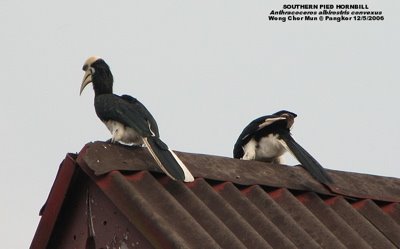 |
| Oriental pied hornbills on rooftop. Photo by Susan Wong |
#2 The Oriental pied hornbills can breed in urban habitats!
While hornbills are mostly forest birds, the Oriental pied hornbill is an exception (Poonswad, 1995). As long as there is sufficient food and large mature trees for nesting, it is able to survive around human habitation (Chong, 1998). From current observations, it would appear that a noisy, busy urban environment poses no barrier to the selection of a nesting site and to successful breeding. Far more problematic for the hornbills would be the availability of a suitable and large enough tree cavity in which to nest.
 |
| Southern pied hornbill chick defecating from the opening of the nest. Photo by Howard Banwell |
 |
| Tail feathers of the southern pied hornbill seen from the nest entrance. Photo by Howard Banwell |
#3 Beware of flying "bombs"...
While the female Oriental pied hornbill is sealed inside the tree cavity, she does not soil the nest but turn around, push her rump to the cavity entrance and defecate forcefully into the air! It is believed that she also clears the droppings of her chicks on a frequent but irregular basis (Banwell & Lim, 2009). When the chicks are grown up, they defecate frequently out of the nest just like their mother did. Whether this is a natural instinct or learned from watching the mother, it is impossible to say.
DISTRIBUTION
I. GLOBAL
Globally, the native range of A. albirostris stretches across the Indian Subcontinent and Southeast Asia, which includes Bangladesh, Bhutan, Brunei, Cambodia, India, Indonesia, Laos, Malaysia, Myanmar, Nepal, Singapore, Thailand, Tibet, and Vietnam.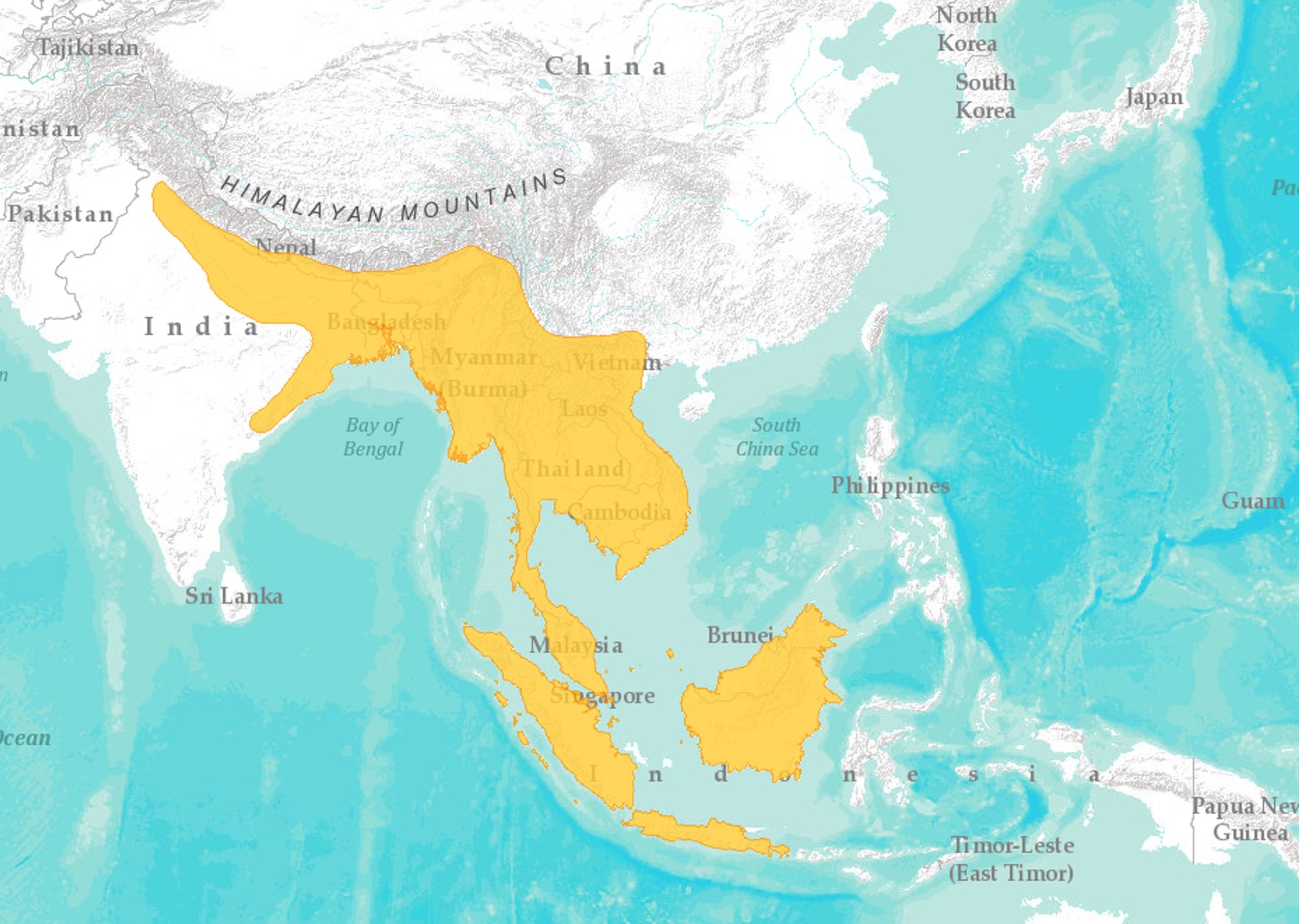 |
| Distribution of A. albirostris regionally (map obtained from IUCN) |
II. SINGAPORE
In Singapore, A. albirostris is mainly distributed in Changi, Pulau Ubin and St John's Island. It has also been introduced into Singapore Botanic Gardens and Sungei Buloh Wetland Reserve.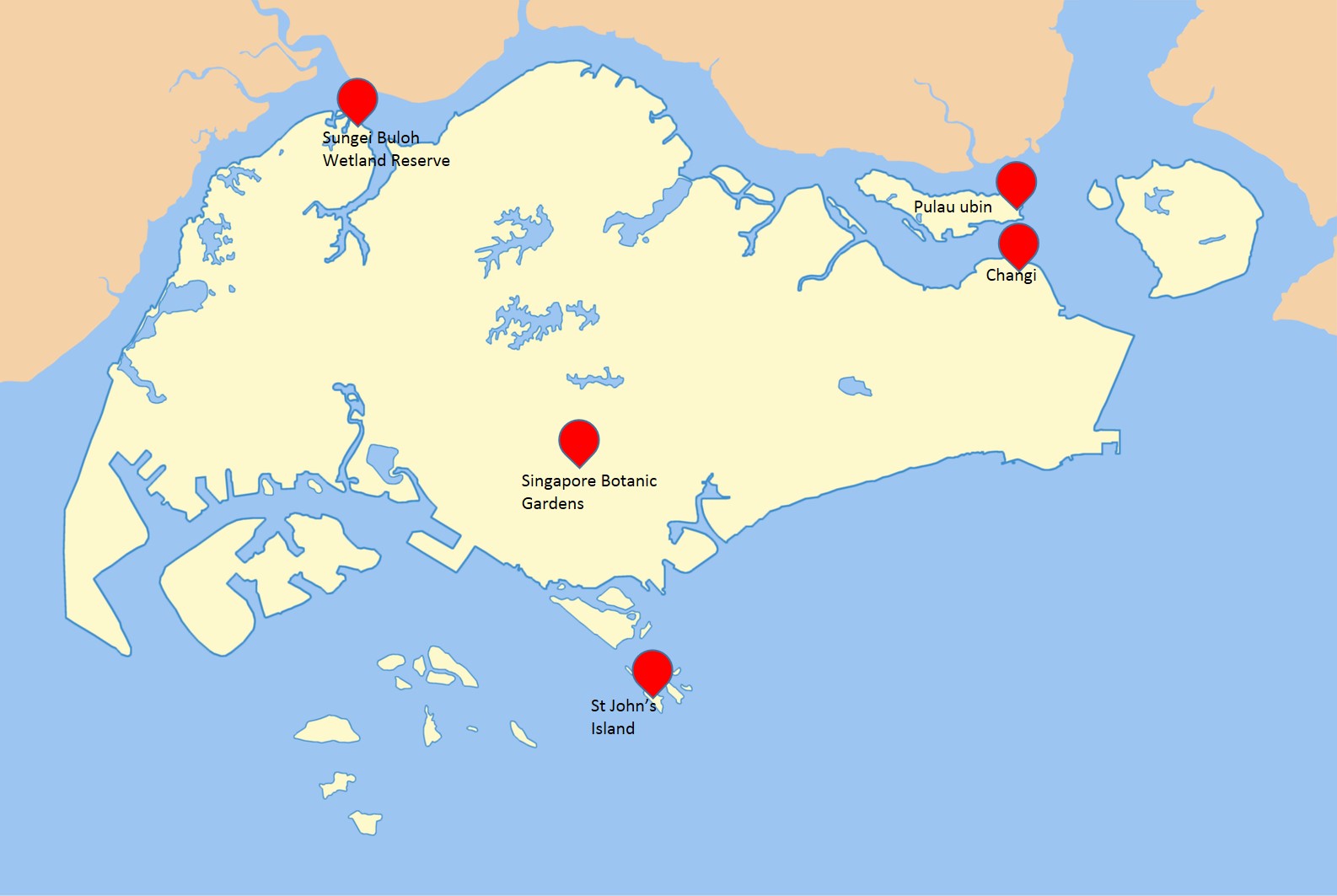 |
| Map of Singapore. Areas of A. albirostris occurrences are indicated by the red flags. |
ECOLOGY
I. ROLE IN THE ENVIRONMENT
As hornbills swallow fruits with large seeds, the latter are regurgitated up to an hour later. With small seeds, these may be passed out with the faeces. As such, they are important seed dispersers, especially for seeds that are too big for smaller birds to eat, and play an important role in the health of the forest.II. ECOLOGICAL FACTORS THAT AFFECT THE SUCCESS OR FAILURE OF REPRODUCTION
- Climate: Drought seems to be an important trigger of the breeding onset of hornbills (Poonswad et al., 1999). They nest during the relatively driest months and prefer dry conditions in the nest cavity. In a study conducted by Poonswad and co-workers (1999), at least 3 known nests of Oriental pied hornbills were abandoned due to floods.
- Availability of nest cavities and nest loss: The most important factor limiting the reproduction of hornbills is the availability of nest cavities, which they cannot excavate by themselves (Poonswad et al., 1999). If nest conditions remained suitable and there was no competition or disturbance, hornbills tended to reuse old nest cavities year after year. However, natural breakage of nest trees by storms accounted for as much as 53.8% of total nest loss, whereas occasional cutting of nest trees by poachers further reduced the availability of suitable nest cavities by 15.4% (Poonswad et al., 1999).
- Intra- and interspecific competition for nest cavities: As the number of suitable cavities were limited, it resulted in intra- and interspecific competition for nest cavities among the 4 sympatric hornbill species (Great hornbill, Wreathed hornbill, Oriental
pied hornbill and Brown hornbill) (Poonswad et al., 1999). Animals other than the hornbills themselves also competed for cavities; these included bees (Apis sp.), resinous bees (Trigona sp.), wasps (Vespa sp.) monitor lizards (Varanus sp.), Red Giant Flying Squirrels (Petaurista petaurista) and King Cobra (Ophiophaga hannah) (Poonswad et al., 1999). - Food: Greater food diversity may enhance breeding success by as much as 91% in the Oriental pied hornbills (Poonswad et al., 1999).
- Predation: Hornbills are known to be preyed upon by some arboreal mammals such as the Yellow-throated Marten (Martes flavigula) (Poonswad et al., 1999). In addition to preying on hornbills, the Yellow-throated Martens also caused the birds to abandon their nests (Poonswad et al., 1999).
THREATS
The survival of the Oriental pied hornbills is closely associated with the quality of their environment. Deforestation in the region and overall human pressure on the environment has posed real threat to the local survival of the species. It was recently noted that this species has been almost completely extirpated from southern China. In the Thai-Malay Peninsula, the species may be threatened by off-take for the trade in fledglings and outright forest clearance. There is some evidence that the species has traditionally been captured for the local pet trade, as historically one to two were reportedly kept in every village in at least some areas of Myanmar. The casques of Oriental pied hornbills are common souvenirs in the markets of Thailand, Laos and Vietnam; however, the extent of this trade has not been measured.CONSERVATION STATUS
I. GLOBAL
The Internation Union for Conservation of Nature (IUCN) lists A. albirostris as a taxon of "Least Concern" due to its large distribution range and stable population trend.II. SINGAPORE
The Singapore Red Data book currently records A. albirostris as "Critically Endangered (CR)". This category criterion is that "There are lesser than 50 mature individuals, OR if more than 50 mature individuals but less than 250, with some evidence of decline or fragmentation" (Davison et al., 2008).THE ORIENTAL PIED HORNBILL IN SINGAPORE
 |
| The Oriental pied hornbill was featured in a local stamp as one of the wonders found in Pulau Ubin. Photo from http://www.ecowalkthetalk.com |
Singapore had its own native Oriental pied hornbills in the 19th century (Gibson-Hill, 1949) until about the 1920s (Robinson, 1927). Due to rapid development and large-scale deforestation, the species appeared to have gone extinct locally until the 1960s when it was irregularly sighted on Singapore island. These birds were thought to be escapees from the wild bird trade (Wang & Hails, 2007). There were two subspecies believed to be breeding in Singapore, the northern pied hornbill (Anthracoceros albirostris albirostris) and southern pied hornbill (Anthracoceros albirostris convexus). In the early 1990s, a pair of hornbills belonging to the convexus subspecies was found to be breeding in the offshore island of Pulau Ubin, and it was speculated that they have flown from the nearby Johore state of Peninsular Malaysia (Lim, 1994; Wee & Subaraj, 2006; Wang & Hails, 2007).
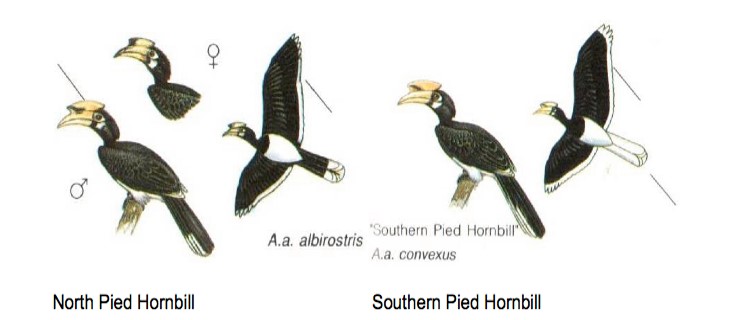 |
| Differentiating the two subspecies of oriental pied hornbills in Singapore (Robson & Allen, 2008) |
TAXONOMY
I. TAXONAVIGATION

II. ORIGINAL DESCRIPTION
III. TYPE INFORMATION
Not availableIV. PHYLOGENETICS
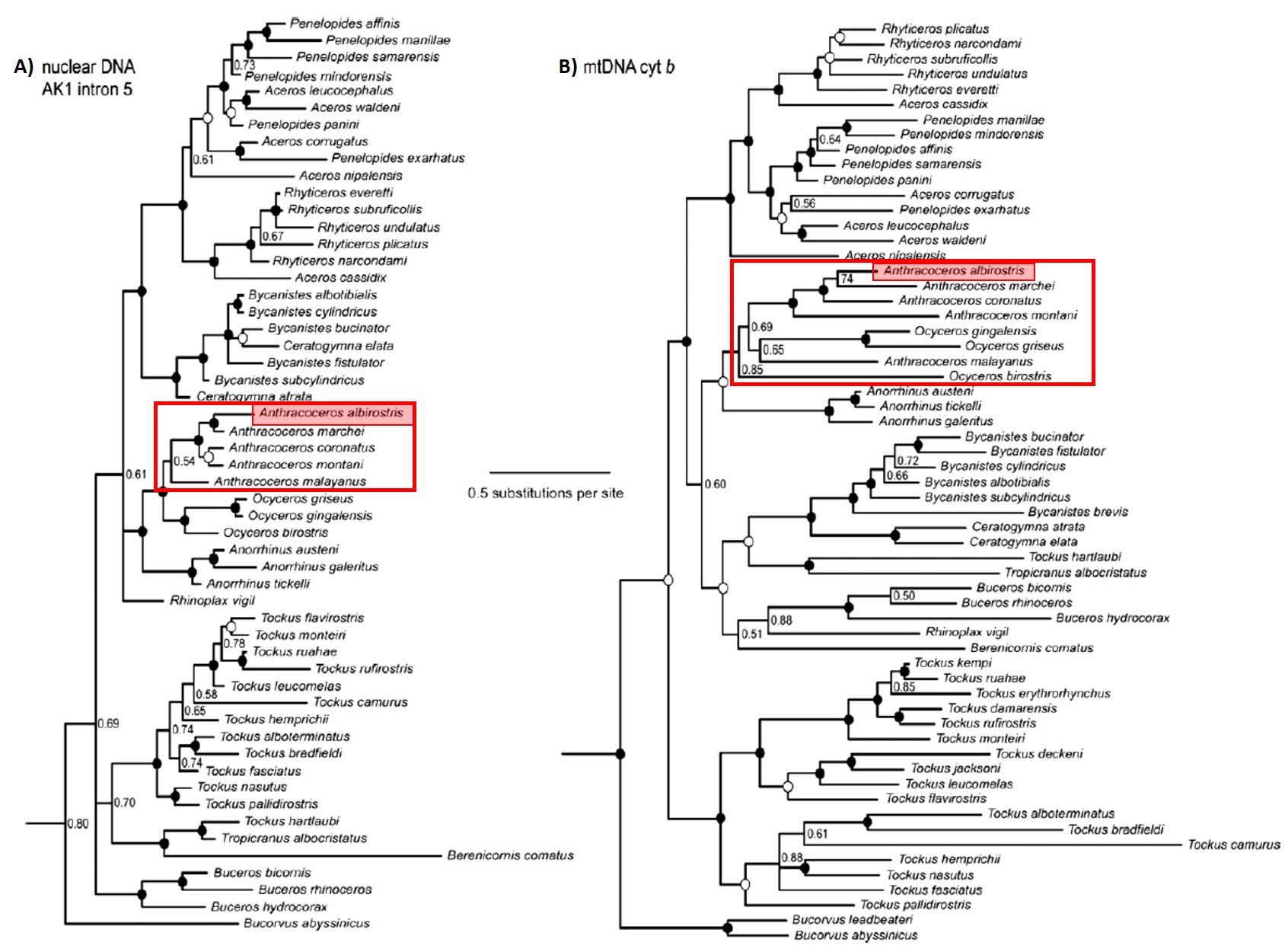
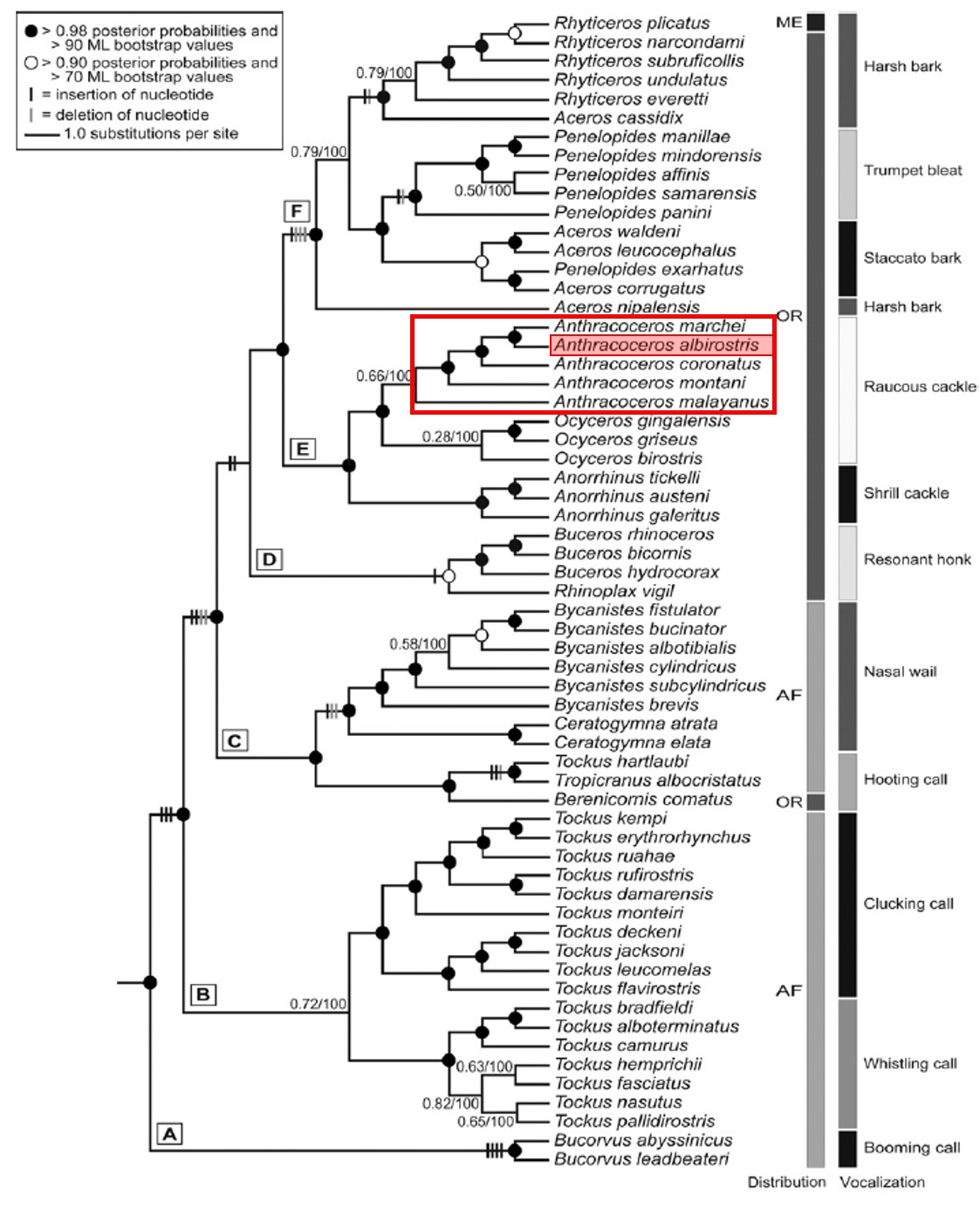
There were minor inconsistencies between clade-level topologies in the nuclear DNA tree and the mtDNA tree. Specifically, Bucerotinae was subdivided into 6-7 clades in the nuclear tree and slightly simplified to 5 prominent clades in the mtDNA and concatenated trees (Gonzalez et al., 2013).
The nuclear tree suggests that Ocyceros and Anthracoceros are reciprocally monophyletic (boxed in red), whereas the mtDNA tree recovered polyphyly of both genera (boxed in red). Concatenated trees were similarly inconsistent, with the "best" tree recovering monophyly (boxed in red), while all other analyses of the combined dataset suggested polyphyly. Further sampling of loci is needed to resolve the phylogenetic relationships between Ocyceros and Anthracoceros (Gonzalez et al., 2013).
USEFUL LINKS
http://eol.orghttp://www.iucnredlist.org
http://www.wildsingapore.com
http://www.birdlife.org
http://rmbr.nus.edu.sg
http://www.birdforum.net
http://www.biodiversitylibrary.org
http://www.waza.org
REFERENCES
Avian Vocalizations Center, Oriental pied hornbill (Anthracoceros albirostris). Retrieved Nov 28, 2013, from http://avocet.zoology.msu.edu/recordings/8559Banwell, H. M. & J. C. W. Lim, 2009. Observations on a successful nesting of a pair of oriental pied hornbills (Anthracoceros albirostris, Shaw & Nodd, 1790) at Changi Village, Singapore. Nature in Singapore, 2: 275-281.
BirdForum, Anthracoceros. Retrieved Nov 19, 2013, from http://www.birdforum.net/opus/Anthracoceros
Bird Ecology Study Group, Oriental pied hornbills. Retrieved Nov 12, 2013, from http://besgroup.blogspot.sg/search?q=oriental+pied+hornbill
BirdLife International (2013) Species factsheet: Anthracoceros albirostris. Retrieved Nov 19, 2013, from http://www.birdlife.org/datazone/speciesfactsheet.php?id=947
Chong, M. H. N., 1998. A survey of hornbills in rain forest habitats of Peninsular Malaysia. In: Poonswad, P. (ed.), The Asian Hornbills: Ecology and Conservation. Thai Studies in Biodiversity, 2: 1–336. Pp. 13–22.
Collar, N. J., 2001. Family Trogonidae (Trogons). In: del Hoyo, J., A. Elliott & J. Sargatal (eds.), Handbook of the Birds of the World. Volume 6. Mousebirds to Hornbills. Lynx Editions, Barcelona. Pp. 80–127.
Davison, G.W. H. and P. K. L. Ng and Ho Hua Chew, 2008. The Singapore Red Data Book: Threatened plants and animals of Singapore. Nature Society (Singapore). 285 pp.
Gibson-Hill, C. A., 1949. An annotated checklist of the birds on Malaya. Bulletin of the Raffles Museum, 20: 1–299.
Gonzalez, J.C., Sheldon, B.C., Collar, N.J. & Tobias, J.A. (2013) A comprehensive molecular phylogeny for the hornbills (Aves: Bucerotidae). Molecular phylogenetics and evolution, 67, 468-483.
Lim, K. S., 1994. Oriental pied hornbill. Iora, 1: 156–158.
National Parks Singapore, Hornbills in the Lion City. Retrieved Nov 12, 2013, from http://mygreenspace.nparks.gov.sg/hornbills-in-the-lion-city/
Poonswad, P., Chimchome, V., Plongmai, K. & Chuilua, P. 1999. Factors influencing the reproduction of Asian hornbills. In: Adams, N.J. & Slotow, R.H. (eds) Proc. 22 Int. Ornithol. Congr., Durban: 1740-1755. Johannesburg: BirdLife South Africa.
Poonswad, P., Tsuji, A. & Ngampongsai, C. 1987. A comparative study on breeding biology of sympatric hornbill species (Bucerotidae) in Thailand with implication for breeding in captivity. In: Proceedings, Delacour/International Foundation for the Conservation of Birds; Symposium on breeding birds in captivity, February 11-15, 1987. North Hollywood: 250 - 315.
Poonswad, P. 1995. Nest site characteristics of four sympatric species of hornbills in Khao Yai National Park, Thailand. Ibis, 137: 183–191.
Robinson, H. C., 1927. The Birds of the Malay Peninsula. Volume I: The Commoner Birds. H. F. & G. Whiterby, London. 329 pp.
Robson, C. & Allen, R. (2008) A Field Guide to the Birds of Thailand and South-East Asia. Asia Books.
Shaw, G. & Stephens, J.F. (1800) General zoology, or Systematic natural history. Printed for G. Kearsley, London,.
The IUCN Red list of Threatened Species, Anthracoceros albirostris. Retrieved Nov 12, 2013, from http://www.iucnredlist.org/details/100600947/0
Wang, L. K. & C. J. Hails, 2007. An annotated checklist of the birds of Singapore. Raffles Bulletin of Zoology, Supplement 15: 1−179.
Wee, Y. C. & R. Subaraj, 2006. Aberrant behaviour of a pair of female great and rhinoceros hornbills in Singapore. Birding Asia, 6: 18–22.
Wild Bird Club of the Philippines, Sulu hornbill. Retrieved Nov 19, 2013, from http://www.birdwatch.ph/html/gallery/suluhornbill1.html









